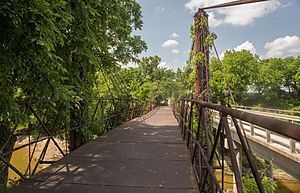Bluff Dale Suspension Bridge facts for kids
Quick facts for kids Bluff Dale Suspension Bridge |
|
|---|---|

Bluff Dale bridge, as seen from the modern bridge that has replaced it for vehicle traffic.
|
|
| Coordinates | 32°21′14″N 98°1′34″W / 32.35389°N 98.02611°W |
| Carries | Pedestrian way on County Road 49 (Berry's Creek Rd.) |
| Crosses | Paluxy River |
| Locale | Berry's Creek Rd., Bluff Dale, Texas |
| Owner | Erath County |
| Characteristics | |
| Design | Cable-stayed |
| Material | Wrought iron |
| Total length | 200 feet (61 m) |
| Width | 13 feet (4.0 m) |
| Longest span | 140 feet (43 m) |
| Number of spans | 3 |
| Piers in water | 2 |
| History | |
| Designer | Edwin Elijah Runyon |
| Construction begin | 1890 |
| Construction end | 1890 |
|
Bluff Dale Bridge
|
|
| Lua error in Module:Location_map at line 420: attempt to index field 'wikibase' (a nil value). | |
| Area | 1 acre (0.40 ha) |
| NRHP reference No. | 77001440 |
| Significant dates | |
| Added to NRHP | December 20, 1977 |
The Bluff Dale Bridge is a very old and special bridge near Bluff Dale, Texas. It was built in 1891. This bridge goes across the Paluxy River. It is about 225 feet (69 m) long.
The part you walk on is about 28 feet (8.5 m) above the river. Strong iron cables hold it up. These cables are attached to tall towers made of iron pipes. The Bluff Dale Bridge is a cable-stayed bridge. This means its deck is held up by cables that go directly from the towers to the bridge deck. It is not a suspension bridge, which uses large main cables that hang between towers.
History of the Bluff Dale Bridge
The Bluff Dale Bridge was first built in 1890. It was on a dirt road that later became a busy highway. In 1933, a new, bigger bridge was built nearby. This new bridge was needed for all the cars.
So, in 1934, the old Bluff Dale Bridge was moved. Workers took it about 1.5 miles (2.4 km) upstream. They also made it a bit longer, from 200 feet (61 m) to 225 feet (69 m).
Because it is so old and unique, the bridge was added to the National Register of Historic Places in 1977. This list helps protect important historical places. However, the bridge got very old and worn out. It was closed to cars in 1989 because it was not safe anymore. Today, people can still walk across it.
How the Bridge Was Built
Even though some old papers called it a "suspension bridge," the Bluff Dale Bridge is actually a cable-stayed bridge. Its deck hangs from many cables that spread out from the towers. Some cables go straight to the deck. Others run all the way from one tower to the other.
This special way of building was designed by Edwin Elijah Runyon. He got a patent for his design. The Bluff Dale Bridge is one of only two bridges built using his unique ideas. The other one is the Barton Creek Bridge in Huckabay, Texas.
The bridge is also special because of its materials. It uses hand-twisted wire cables. It also uses iron pipes in a different way than most bridges. This makes it a great example of how bridges were built in America a long time ago.

